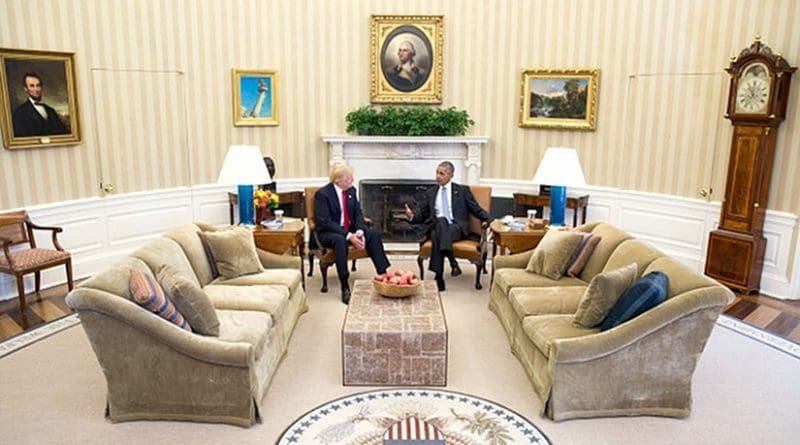Trump Vs Obama: US Policy Towards Adversarial States – Analysis
By IPCS
By Kimberley Anne Nazareth*
During the Obama presidency, US policy towards Syria, Iran and North Korea rested on a ‘carrot and stick’ approach with greater emphasis on the carrots. The Trump administration, while following a similar approach, appears to be willing to use more sticks. The recent air strikes on Syria’s Al Shayrat airbase sanctioned by President Trump in response to the chemical attacks by the Assad regime, have demonstrated a clear shift in strategy since the Obama administration. There are also indications of the possibility of US military strikes against North Korea; for instance the deployment of the Carl Vonson carrier, and against Iran in future. The question is: to what extent, and in what forms, will the Trump administration bring with it continuity or change in its dealings with adversarial states, in this case, Syria, Iran and North Korea?
Syria
Obama seemed hesitant of military intervention in Syria. US strategy hinged on a couple of factors, which included the objective of avoiding another Libya, the unorganised anti-Assad rebels, and Russian involvement, to name a few. In spite of the use of chemical weapons by the Assad regime in2013, which crossed Obama’s ‘redline’, the then US administration refrained from using force. Obama’s policy towards Syria has been considered a failure as Assad is still in power, the civil war continues, and the peace process has become redundant.
On the other hand, the Trump administration seems more decisive in terms of policy. Trump’s rhetoric in comparison to the past has undergone a shift, from avoiding involvement to getting involved. US policy for the moment seems more in tune with action than inaction. This was evident with the recent US strike. The Trump administration responded decisively by ordering 59 Tomahawk missile strikes on the Syrian airfield. The administration has also signalled further action against Syria but has been unclear on the nature of potential action. Having said this, current US policy towards Syria has its own set of problems. Notwithstanding the obstacles, the larger question is, how far is Trump willing to go and what lengths is he willing to cross in his policy towards Syria?
Iran
Obama’s policy towards Iran hinged on ‘engagement’, but more accurately it separated the nuclear deal/Joint Comprehensive Plan of Action (JCPOA) from the Iranian ballistic missile programme. That is, the Obama administration found it prudent to impose sanctions on Iran’s ballistic missiles programme while simultaneously lifting sanctions when it came to the JCPOA.
This policy has so far been continued by the current administration. Trump has carried forward the sanctions imposed by Obama on the ballistic missiles programme, which were authorised by UN Resolutions 2231. In fact, the Trump administration has also imposed sanctions as per the lists drawn up by the previous administration. This strategy makes it clear that both the US and Iran indirectly agree that all the issues that fall outside the JCPOA are fair game. Thus, in considering US policy towards Iran, there seems to be greater continuity.
North Korea
Obama’s carrot and stick policy to rein in the North Korean nuclear as well as ballistic missile programmes was unsuccessful. His policy of ‘strategic patience’, which was successful with Iran was unsuccessful in the case of North Korea.
During the US election campaign, candidate Trump dabbled with the idea of a ‘face-to-face’ meeting with North Korean leader Kim Jong-un. Recently, there have been back and forth provocations between the two, from the testing of ballistic missiles by North Korea, to the US deployment of the Terminal High Altitude Air Defense (THAAD) system in South Korea, which provoked Pyongyang’s ‘nuclear threat’, in turn propelling the US to put the military option on the table. More recently, the aircraft carrier USS Carl Vinson and its escorts were diverted to the Korean Peninsula. These appear to be stronger measures against North Korea, and are signs of decisive action by the US to assure its regional allies. Irrespective of campaign rhetoric, the Trump administration seems more willing to not only maintain the status quo but enforce it with greater vigour, thus strengthening the idea of ‘support any friend.’ Although the current US strategy seems to be more decisive than before, is it is a wise choice in terms of future implications?
Conclusion
A comparison of Obama’s approach and the Trump administration’s still evolving policy towards adversarial states reveals marked changes in US strategy towards Syria and North Korea. Trump seems willing to use more sticks in his strategy towards adversaries. However, in the case of Iran, there seems to be greater continuity in US policy, which could be to avoid getting in the way of the JCPOA.
The down side to this strategy could be in terms of a regional fallout. Given the mounting regional challenges, the question is whether Trump’s strong actions towards Syria and North Korea are a good idea for all the stakeholders involved. The Trump administration will have to tread ahead with caution and carefully evaluate the marked difference in the behaviour of all three countries and the interests of the other stakeholders involved.
* Kimberley Anne Nazareth
Researcher, Nuclear Security Programme (NSP), IPCS

